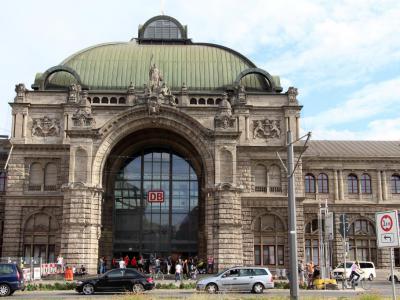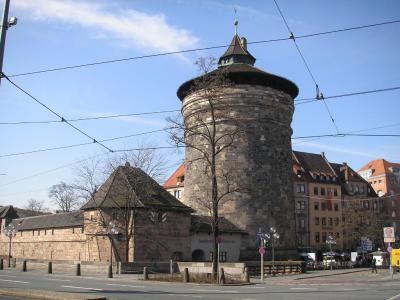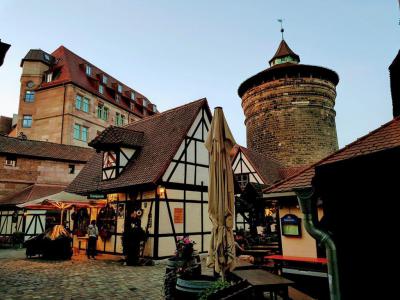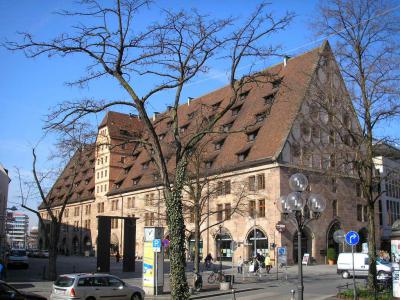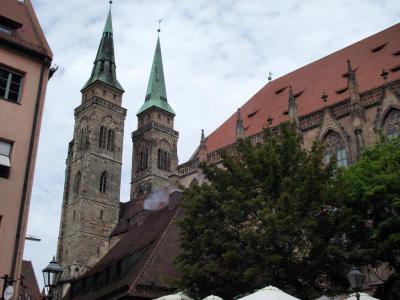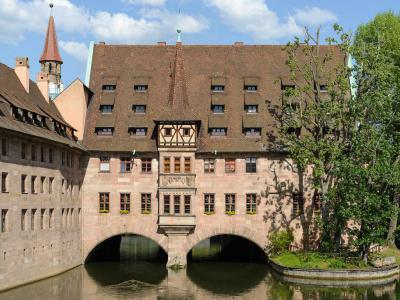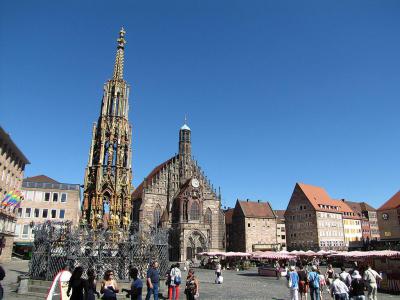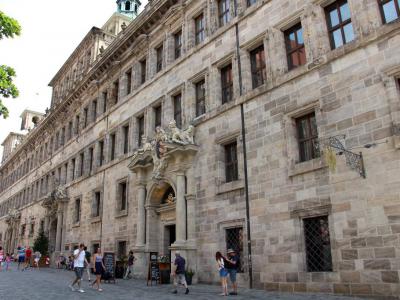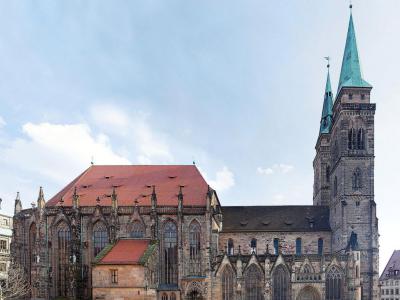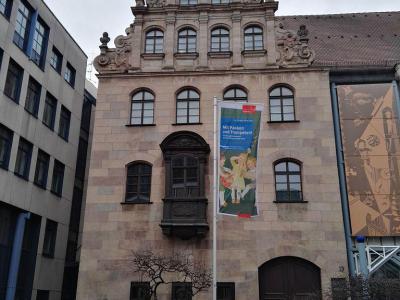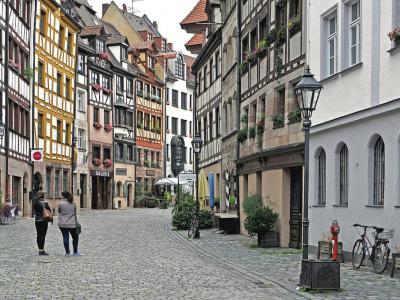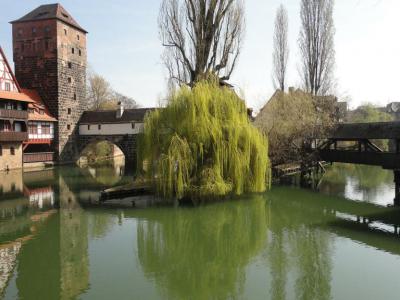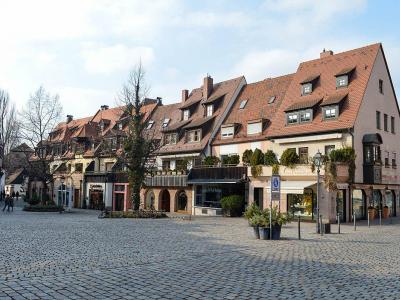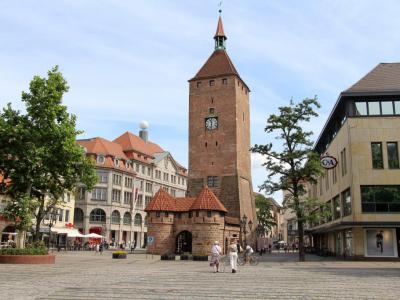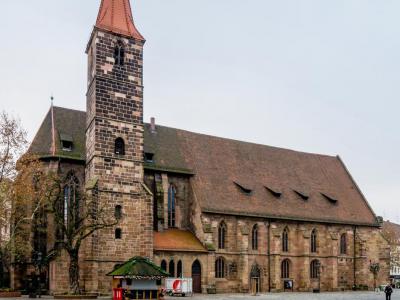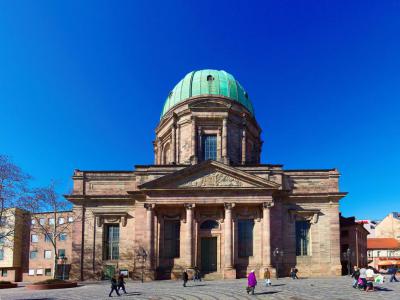Nuremberg Old Town Walking Tour (Self Guided), Nuremberg
The historical center of Nuremberg, Old Town (German: Altstadt) is easily differentiated from other parts of the city. Divided in two by the Pegnitz River, the district represents a complex architectural ensemble with a maze of historical lanes (e.g. Weissgerbergasse) packed with half-timber houses, linked by centuries-old bridges, such as Maxbrücke, and set against the picturesque backdrops of large churches like St. Sebaldus' and St. Lawrence's, as well as medieval sites like the Heilig-Geist-Spital found along the banks.
Under the Nazi dictatorship, the Old City was cleansed of everything ideologically unsuitable, plus the Allied air raids nearly totally destroyed much of what was left by the end of World War II. Luckily, as early as in 1945, reconstruction began, and in 1950 a general plan was outlined, set to restore the Old Town structure. Today, this historical area is just as gorgeous as it once was, fit to make anyone walk around for hours, not getting enough of it.
If you arrive in Central Station – the imposing Neo-Baroque edifice, the birthplace of the German railway – you can start your journey near the Frauentorturm, one of the four main towers in Nuremberg's medieval fortification, and proceed in the direction of the Imperial Castle. Pretty much all the attractions along the way will be worthy of attention, be it the Mauthalle (Former Customs House) from the late 15th century; Hauptmarkt (Main Market Square) – center of local commerce since ancient times; or the Rathaus (City Hall) – one of the most important buildings in Nuremberg; to mention but a few.
The city's medieval center is best explored on foot. All you need, apart from GPSmyCity mobile app, to enjoy this self-guided walking tour are a pair of comfortable shoes, a backpack, and a camera.
Under the Nazi dictatorship, the Old City was cleansed of everything ideologically unsuitable, plus the Allied air raids nearly totally destroyed much of what was left by the end of World War II. Luckily, as early as in 1945, reconstruction began, and in 1950 a general plan was outlined, set to restore the Old Town structure. Today, this historical area is just as gorgeous as it once was, fit to make anyone walk around for hours, not getting enough of it.
If you arrive in Central Station – the imposing Neo-Baroque edifice, the birthplace of the German railway – you can start your journey near the Frauentorturm, one of the four main towers in Nuremberg's medieval fortification, and proceed in the direction of the Imperial Castle. Pretty much all the attractions along the way will be worthy of attention, be it the Mauthalle (Former Customs House) from the late 15th century; Hauptmarkt (Main Market Square) – center of local commerce since ancient times; or the Rathaus (City Hall) – one of the most important buildings in Nuremberg; to mention but a few.
The city's medieval center is best explored on foot. All you need, apart from GPSmyCity mobile app, to enjoy this self-guided walking tour are a pair of comfortable shoes, a backpack, and a camera.
How it works: Download the app "GPSmyCity: Walks in 1K+ Cities" from Apple App Store or Google Play Store to your mobile phone or tablet. The app turns your mobile device into a personal tour guide and its built-in GPS navigation functions guide you from one tour stop to next. The app works offline, so no data plan is needed when traveling abroad.
Nuremberg Old Town Walking Tour Map
Guide Name: Nuremberg Old Town Walking Tour
Guide Location: Germany » Nuremberg (See other walking tours in Nuremberg)
Guide Type: Self-guided Walking Tour (Sightseeing)
# of Attractions: 17
Tour Duration: 3 Hour(s)
Travel Distance: 3.8 Km or 2.4 Miles
Author: Ella
Sight(s) Featured in This Guide:
Guide Location: Germany » Nuremberg (See other walking tours in Nuremberg)
Guide Type: Self-guided Walking Tour (Sightseeing)
# of Attractions: 17
Tour Duration: 3 Hour(s)
Travel Distance: 3.8 Km or 2.4 Miles
Author: Ella
Sight(s) Featured in This Guide:
- Nuremberg Central Station
- Frauentorturm (Women's Gate Tower)
- Handwerkerhof (Crafts Yard)
- Mauthalle (Former Customs House)
- St. Lawrence's Church
- Heilig-Geist-Spital (Hospice of the Holy Spirit)
- Hauptmarkt (Main Market Square)
- City Hall (Rathaus)
- St. Sebaldus Church
- Nuremberg Toy Museum
- Weissgerbergasse (Weissgerber Street)
- Maxbrücke (Max Bridge)
- Trodelmarkt (Flea Market)
- Ludwigsplatz (Ludwig's Square)
- St. Jakobskirche (St. Jacob's Church)
- St. Elizabeth's Cathedral
- Zum Guldenen Stern Restaurant
1) Nuremberg Central Station
Nuremberg Central Station stands as a prominent transportation hub in northern Bavaria, classified among the top 20 most significant stations due to its substantial role and historical significance. Situated on the southeastern edge of Nuremberg's Old Town (Altstadt), the station faces the historic King's Gate (Königstor). This strategic location not only facilitates easy access to the city's core but also places it near notable landmarks such as the DB Museum and the Staatstheater Nürnberg opera house.
The architectural evolution of the station is marked by its transition from neo-Gothic to neo-Baroque styles. Originally built in the neo-Gothic style, the station underwent a significant reconstruction in 1900 adopting a largely neo-Baroque aesthetic. A notable feature of the station is its Muschelkalk facade which provides a distinctive external appearance. The station's portals are intricately adorned, displaying symbols of technological advancement like the winged wheel above the Mittelhalle portal, embodying the era's industrial spirit.
The interior of the station boasts a Jugendstil lounge designed by Bruno Paul in 1904, which survived the devastations of the Second World War. This area is renowned for its elegant mosaics and subtle stucco work on the roof, presenting a historic ambiance that complements the modern-day travel center located within. Additionally, an advertising column from the early 20th century, placed above the main portal, adds to the historical charm of the station.
Despite plans in 1950 to revert the architectural style to neo-Gothic, these were largely halted before significant changes could be made, leaving only minor modifications. This decision preserved the unique Neo-Baroque character of the station, making Nuremberg Central Station not only a crucial transportation node but also a cultural and historical landmark in the heart of Nuremberg.
Why You Should Visit:
While the building itself is very nice it is worth noting that the reason Nuremberg was chosen for the Nazi rallying grounds was its ability to link Germany by rail, so this central station is historical as well.
The architectural evolution of the station is marked by its transition from neo-Gothic to neo-Baroque styles. Originally built in the neo-Gothic style, the station underwent a significant reconstruction in 1900 adopting a largely neo-Baroque aesthetic. A notable feature of the station is its Muschelkalk facade which provides a distinctive external appearance. The station's portals are intricately adorned, displaying symbols of technological advancement like the winged wheel above the Mittelhalle portal, embodying the era's industrial spirit.
The interior of the station boasts a Jugendstil lounge designed by Bruno Paul in 1904, which survived the devastations of the Second World War. This area is renowned for its elegant mosaics and subtle stucco work on the roof, presenting a historic ambiance that complements the modern-day travel center located within. Additionally, an advertising column from the early 20th century, placed above the main portal, adds to the historical charm of the station.
Despite plans in 1950 to revert the architectural style to neo-Gothic, these were largely halted before significant changes could be made, leaving only minor modifications. This decision preserved the unique Neo-Baroque character of the station, making Nuremberg Central Station not only a crucial transportation node but also a cultural and historical landmark in the heart of Nuremberg.
Why You Should Visit:
While the building itself is very nice it is worth noting that the reason Nuremberg was chosen for the Nazi rallying grounds was its ability to link Germany by rail, so this central station is historical as well.
2) Frauentorturm (Women's Gate Tower)
The Women's Gate Tower (Frauentorturm), also historically known as the "Blau Q," stands as a significant medieval landmark in Nuremberg. This tower is one of the four major towers that were integral to the fortifications of Nuremberg’s Old Town. Positioned on the southeastern side, it was strategically placed to guard the Frauentor, or Women's Gate, which was a crucial entry point into the city from the route leading to Regensburg.
The name 'Frauentor' is derived from its proximity to the Klarakloster, the Poor Clare Convent of Saint Klara, hinting at the historical significance of the area in terms of both defense and local culture. Documentation regarding the construction of the Frauentorturm is sparse, but payment records to the gatekeeper from as early as 1386 suggest that the gate was operational by this time, marking the likely completion of its construction.
Originally, the tower formed part of an earlier phase of the city walls before being replaced by the current structure following the demolition of the inner Frauentor in 1498-a change coinciding with the construction of The Mauthalle, the city’s customs house. In 1558, the Frauentorturm underwent significant remodeling to achieve its present-day rounded shape, which included the addition of a side gate.
With the completion of the Königstor in 1849, the Frauentor was relegated to managing outgoing traffic. In contemporary times, the gate is exclusively pedestrian and hosts the Nuremberg Crafts Yard within what was once its armory, providing a vibrant cultural and commercial space for both locals and visitors.
Due to its prominent location opposite the Central Railway Station, the Women's Gate Tower is often one of the first historical sights encountered by visitors arriving in Nuremberg by train, serving as a striking introduction to the city’s rich medieval heritage.
The name 'Frauentor' is derived from its proximity to the Klarakloster, the Poor Clare Convent of Saint Klara, hinting at the historical significance of the area in terms of both defense and local culture. Documentation regarding the construction of the Frauentorturm is sparse, but payment records to the gatekeeper from as early as 1386 suggest that the gate was operational by this time, marking the likely completion of its construction.
Originally, the tower formed part of an earlier phase of the city walls before being replaced by the current structure following the demolition of the inner Frauentor in 1498-a change coinciding with the construction of The Mauthalle, the city’s customs house. In 1558, the Frauentorturm underwent significant remodeling to achieve its present-day rounded shape, which included the addition of a side gate.
With the completion of the Königstor in 1849, the Frauentor was relegated to managing outgoing traffic. In contemporary times, the gate is exclusively pedestrian and hosts the Nuremberg Crafts Yard within what was once its armory, providing a vibrant cultural and commercial space for both locals and visitors.
Due to its prominent location opposite the Central Railway Station, the Women's Gate Tower is often one of the first historical sights encountered by visitors arriving in Nuremberg by train, serving as a striking introduction to the city’s rich medieval heritage.
3) Handwerkerhof (Crafts Yard)
The Crafts Yard opened in 1971 and features traditional crafts. Visitors and locals can watch craft creators at work using traditional tools to create handmade goods. The Crafts Yard invited visitors to go back to a time period when goods were painstakingly made by hand and were treasured possessions, often passed from generation to generation.
The Crafts Yard is located in the Free Imperial City's former armory. Surrounded by the ancient town wall, the Crafts Yard features narrow walkways, half-timbered houses, and cozy inns.
As you stroll through the yard, you can walk tinsmiths and woodworkers making toys and goldsmiths creating art. Crafters create traditional goods such as model railways, miniature doll prams, and handmade figurines.
The yard hosts exhibitions showcasing crafting traditions such as bookbinding and gingerbread making.
Visitors can watch the artists at work as well as purchase these unique items. Bring home beautifully handmade souvenirs and gifts.
The Crafts Yard also has delightful cafes, restaurants, and bars sprinkled about the craft shops.
The Crafts Yard is located in the Free Imperial City's former armory. Surrounded by the ancient town wall, the Crafts Yard features narrow walkways, half-timbered houses, and cozy inns.
As you stroll through the yard, you can walk tinsmiths and woodworkers making toys and goldsmiths creating art. Crafters create traditional goods such as model railways, miniature doll prams, and handmade figurines.
The yard hosts exhibitions showcasing crafting traditions such as bookbinding and gingerbread making.
Visitors can watch the artists at work as well as purchase these unique items. Bring home beautifully handmade souvenirs and gifts.
The Crafts Yard also has delightful cafes, restaurants, and bars sprinkled about the craft shops.
4) Mauthalle (Former Customs House)
This medieval building has served as a granary and customhouse throughout its centuries-old history. It was built as a granary around 1498 on the site of the former city moat. At the time, this was the largest grain house in the city and stored food for times of crisis.
The Former Customs House features a gabled roof. The eastern gable has an intricate network of blind ogee arches. The city's coat of arms, with the imperial eagle, is featured in the lancet-arched portal.
The impressive roof has five stories and rests on top of the three-story sandstone building.
The granary began serving as a customhouse in 1572. The building was heavily damaged during WWII but has been restored. The original builders used half-timbers on the facade; the remaining half-timbered facade can be seen on the building's easter wing. The rest of the building was rebuilt using brick.
The cellar features 26 pillars and now houses the Barefoot brewery and restaurant.
The Former Customs House features a gabled roof. The eastern gable has an intricate network of blind ogee arches. The city's coat of arms, with the imperial eagle, is featured in the lancet-arched portal.
The impressive roof has five stories and rests on top of the three-story sandstone building.
The granary began serving as a customhouse in 1572. The building was heavily damaged during WWII but has been restored. The original builders used half-timbers on the facade; the remaining half-timbered facade can be seen on the building's easter wing. The rest of the building was rebuilt using brick.
The cellar features 26 pillars and now houses the Barefoot brewery and restaurant.
5) St. Lawrence's Church (must see)
Saint Lawrence's Church in Nuremberg stands as a testament to both the resiliency and rich artistic heritage of the region. Dedicated to Saint Lawrence, a revered Roman Catholic saint, the church is primarily noted for its transformation and significance within the Evangelical Lutheran tradition, particularly after it was one of the first to adopt Lutheranism in 1525. This historic church suffered considerable damage during World War II but was meticulously restored, preserving its status as a prominent landmark in Bavaria.
Architecturally, the church is celebrated for its splendid Gothic elements, particularly the "Saint Laurentius" choir, designed by the medieval master mason Konrad Roriczer in 1445. This choir is a masterpiece of Gothic design and craftsmanship, highlighting the church's architectural significance.
Artistically, Saint Lawrence's Church houses an impressive collection of medieval art, including altarpieces from the 14th and 15th centuries, with the earliest dating back to 1316. Among its notable sculptures is the "beautiful Madonna," an unusually cheerful representation from around 1280. Additionally, the church features a remarkable stone tabernacle created between 1493 and 1496, adorned with carvings that depict the Passion of Christ and capped with a dramatic array of pinnacles that reach up to the vaulting, soaring 20 meters high.
The church also boasts an exceptional collection of medieval stained glass, primarily from the 15th century, adding a vibrant splash of color and artistry to its interior. This collection survived the turbulent times of the Reformation, largely due to the determination of Nuremberg's affluent citizens who, during the Reformation's iconoclasm, chose to preserve these artworks as a tribute to their ancestors.
The west facade of the church is a striking feature, reflecting the opulence of the Nuremberg citizenry. It is distinguished by its two towers and an elaborate West portal that echoes the grandeur of Saint Sebald and Bamberg Cathedral, complete with a commanding rose window that measures 9 meters in diameter.
Architecturally, the church is celebrated for its splendid Gothic elements, particularly the "Saint Laurentius" choir, designed by the medieval master mason Konrad Roriczer in 1445. This choir is a masterpiece of Gothic design and craftsmanship, highlighting the church's architectural significance.
Artistically, Saint Lawrence's Church houses an impressive collection of medieval art, including altarpieces from the 14th and 15th centuries, with the earliest dating back to 1316. Among its notable sculptures is the "beautiful Madonna," an unusually cheerful representation from around 1280. Additionally, the church features a remarkable stone tabernacle created between 1493 and 1496, adorned with carvings that depict the Passion of Christ and capped with a dramatic array of pinnacles that reach up to the vaulting, soaring 20 meters high.
The church also boasts an exceptional collection of medieval stained glass, primarily from the 15th century, adding a vibrant splash of color and artistry to its interior. This collection survived the turbulent times of the Reformation, largely due to the determination of Nuremberg's affluent citizens who, during the Reformation's iconoclasm, chose to preserve these artworks as a tribute to their ancestors.
The west facade of the church is a striking feature, reflecting the opulence of the Nuremberg citizenry. It is distinguished by its two towers and an elaborate West portal that echoes the grandeur of Saint Sebald and Bamberg Cathedral, complete with a commanding rose window that measures 9 meters in diameter.
6) Heilig-Geist-Spital (Hospice of the Holy Spirit)
The Hospice of the Holy Spirit was completed in 1339. The Imperial Mayor built it to provide care to the poor and needy in the area. At the time, it was the largest hospital in the Empire.
The hospital was expanded in the 16th century and stretched over the Pegntiz River. Today, visitors can view the "Sude," which housed the preacher, and the northern wall of the Hospice Church. The church has a polygonal roof turret.
An additional chapel that fell into ruins housed the crown jewels of the Empire from 1424 to 1796. These crown jewels included royal regalia and the Holy Lance, which was shown to believers once a year. In addition, the royal regalia would be transported to Frankfurt Cathedral for coronations.
The hospital houses Nuremberg's oldest bronze sculpture, which was created around 1380. Adam Kraft's Calvary dates to the early 1500s and is located in the Crucifixion Courtyard.
Today, the Hospice of the Holy Spirit houses a senior home as well as a restaurant. The medieval architecture reflecting over the river makes for an impressive photo opportunity.
The hospital was expanded in the 16th century and stretched over the Pegntiz River. Today, visitors can view the "Sude," which housed the preacher, and the northern wall of the Hospice Church. The church has a polygonal roof turret.
An additional chapel that fell into ruins housed the crown jewels of the Empire from 1424 to 1796. These crown jewels included royal regalia and the Holy Lance, which was shown to believers once a year. In addition, the royal regalia would be transported to Frankfurt Cathedral for coronations.
The hospital houses Nuremberg's oldest bronze sculpture, which was created around 1380. Adam Kraft's Calvary dates to the early 1500s and is located in the Crucifixion Courtyard.
Today, the Hospice of the Holy Spirit houses a senior home as well as a restaurant. The medieval architecture reflecting over the river makes for an impressive photo opportunity.
7) Hauptmarkt (Main Market Square) (must see)
The Main Market Square has been the center of activity and commerce in Nuremberg since ancient times. The celebrated marketplace runs Monday through Saturday. Visitors and locals love to shop the plentiful fruits and vegetables, fresh bread, treats, ready-to-eat meals, and fresh flowers.
The Main Market Square features several iconic landmarks. The Beautiful Fountain was completed in 1396 and is a Gothic masterpiece. It stands an impressive 19 meters (62 feet) tall.
Forty ornate figures decorate the fountain. The figures represent important icons in the Holy Roman Empire such as philosophy, liberal arts, the four Church Fathers, the four Evangelists, the seven Prince-electors, the Nine Worthies, Moses, and the seven Prophets. Legend tells of good luck brought to visitors who spin the two brass rings on the fence.
Another impressive landmark on the square is The Church of Our Lady. This Gothic church was built in the 14th century and features a beautiful facade.
The Main Market Square hosts various festivals and events throughout the year. Popular events include the Nuremberg Flea Market, the Nuremberg Old Town Festival, and the Christmas market.
The Main Market Square features several iconic landmarks. The Beautiful Fountain was completed in 1396 and is a Gothic masterpiece. It stands an impressive 19 meters (62 feet) tall.
Forty ornate figures decorate the fountain. The figures represent important icons in the Holy Roman Empire such as philosophy, liberal arts, the four Church Fathers, the four Evangelists, the seven Prince-electors, the Nine Worthies, Moses, and the seven Prophets. Legend tells of good luck brought to visitors who spin the two brass rings on the fence.
Another impressive landmark on the square is The Church of Our Lady. This Gothic church was built in the 14th century and features a beautiful facade.
The Main Market Square hosts various festivals and events throughout the year. Popular events include the Nuremberg Flea Market, the Nuremberg Old Town Festival, and the Christmas market.
8) City Hall (Rathaus)
The City Hall is one of the most important buildings in Nuremberg. Construction of this imposing building began in 1332. The oldest part of the complex is the great ceremonial hall, a stunning example of Gothic architecture. When it was completed in 1340, the ceremonial hall was the largest in the area.
The city hall was expanded in the early 17th century. Architect Jakob Wolff designed a palazzo-like building that is reminiscent of the Italian Renaissance. The facade features three Baroque portals, and the central portal contains the city's two coats of arms and the imperial eagle.
In 1649, the city celebrated the end of the Thirty Year's War with a massive Peace Banquet in the city hall.
Replicas of medieval imperial regalia are on display on the first floor. In the cellar, visitors will find medieval dungeons.
Bombs destroyed city Hall during WWII. However, it was painstakingly reconstructed and reopened in 1962.
The city hall was expanded in the early 17th century. Architect Jakob Wolff designed a palazzo-like building that is reminiscent of the Italian Renaissance. The facade features three Baroque portals, and the central portal contains the city's two coats of arms and the imperial eagle.
In 1649, the city celebrated the end of the Thirty Year's War with a massive Peace Banquet in the city hall.
Replicas of medieval imperial regalia are on display on the first floor. In the cellar, visitors will find medieval dungeons.
Bombs destroyed city Hall during WWII. However, it was painstakingly reconstructed and reopened in 1962.
9) St. Sebaldus Church
Saint Sebaldus Church, situated at Albrecht-Dürer-Platz in Nuremberg, in front of the old city hall, is a landmark steeped in deep historical and religious significance. Named after Sebaldus, an 8th-century hermit and missionary who is also the patron saint of Nuremberg, the church has played a central role in the city's spiritual life since its construction in the 1230s. Originally built as a Romanesque basilica featuring two choirs, Saint Sebaldus Church is notable for its architectural evolution over the centuries. The addition of two towers in the 15th century and further interior modifications in the middle 17th century, which introduced Baroque elements and galleries, mark significant periods in its development.
The church has endured its share of tribulations, most notably suffering severe damage during World War II. However, it was meticulously reconstructed, preserving some of its most valued historical components. Among these are the Shrine of Saint Sebaldus, renowned works by the artist Veit Stoss, and its exquisite stained glass windows. These elements highlight the church's artistic and religious heritage, contributing to its status as a cultural treasure.
Music has also played a pivotal role in the church's history. Notably, it housed an organ as early as the 14th century, with the main organ built in 1440–41 by Heinrich Traxdorf, a pioneer in organ building. This organ was particularly remarkable not only for its age but also for its innovative design which moved away from the traditional Gothic Blockwerk.
Today, Saint Sebaldus Church remains a vital part of Nuremberg’s cultural and spiritual landscape, offering a rich tapestry of history, art, and music to worshippers and visitors alike.
Why You Should Visit:
Great atmosphere that puts you back into medieval times! Also in a beautiful area, just off the northwest corner of the Main Market.
Tip:
Admission is free at the public church tours, although donations are appreciated. For tower tours, the fee is €5 (children €2).
Several times a year, the church and tower are open until late at night, as part of the "Blue Night" festivities in Nuremberg.
The church has endured its share of tribulations, most notably suffering severe damage during World War II. However, it was meticulously reconstructed, preserving some of its most valued historical components. Among these are the Shrine of Saint Sebaldus, renowned works by the artist Veit Stoss, and its exquisite stained glass windows. These elements highlight the church's artistic and religious heritage, contributing to its status as a cultural treasure.
Music has also played a pivotal role in the church's history. Notably, it housed an organ as early as the 14th century, with the main organ built in 1440–41 by Heinrich Traxdorf, a pioneer in organ building. This organ was particularly remarkable not only for its age but also for its innovative design which moved away from the traditional Gothic Blockwerk.
Today, Saint Sebaldus Church remains a vital part of Nuremberg’s cultural and spiritual landscape, offering a rich tapestry of history, art, and music to worshippers and visitors alike.
Why You Should Visit:
Great atmosphere that puts you back into medieval times! Also in a beautiful area, just off the northwest corner of the Main Market.
Tip:
Admission is free at the public church tours, although donations are appreciated. For tower tours, the fee is €5 (children €2).
Several times a year, the church and tower are open until late at night, as part of the "Blue Night" festivities in Nuremberg.
10) Nuremberg Toy Museum (must see)
Nuremberg has been building beloved toys for over 600 years. Its artists have created dolls, pewter figurines, and modern toys.
Lydia Bayer began collecting toys in the 1920s. After Lydia's death, her daughter opened the Lydia Bayer Museum and displayed the impressive collection. The Bayer heirs later collaborated with the city to open the Toy Museum.
Today, the Toy Museum features over 80,000 items and houses several exhibits.
The Lydia Bayer "Cabinet" commemorates Lydia Bayer and her daughter, who were vital to the museum's collection and success. The room features some of Bayers' finest pieces.
In the Dolls, Parlors, Kitchens exhibit, visitors can see four centuries of dolls, mini-kitchens, market stalls, and shops. Girls were historically encouraged to play in these kitchens and shopping replicas to prepare them for life as housewives.
In this exhibit, visitors can discover how dolls have evolved through the centuries.
The Technology and Work exhibit shows off toys that reflect technical achievements. As new inventions and technologies were introduced, toys quickly followed. Children and adults alike wanted miniature versions of the steam engine, railroad, telephone, automobile, and airplane. These technology toys were made of iron and often featured clockwork mechanisms. This area features metal toys made in America. Visitors will be impressed by the model cars, trains, and model railways.
In the Toys Since 1945 section, visitors can see modern toys such as Matchbox cars and Barbie dolls.
On the top floor, visitors will find a wonderful play area for kids. In addition, there's a builder's shed, and artistic handicrafts are available. Finally, there's an outdoor play area where kids can play classic games.
Lydia Bayer began collecting toys in the 1920s. After Lydia's death, her daughter opened the Lydia Bayer Museum and displayed the impressive collection. The Bayer heirs later collaborated with the city to open the Toy Museum.
Today, the Toy Museum features over 80,000 items and houses several exhibits.
The Lydia Bayer "Cabinet" commemorates Lydia Bayer and her daughter, who were vital to the museum's collection and success. The room features some of Bayers' finest pieces.
In the Dolls, Parlors, Kitchens exhibit, visitors can see four centuries of dolls, mini-kitchens, market stalls, and shops. Girls were historically encouraged to play in these kitchens and shopping replicas to prepare them for life as housewives.
In this exhibit, visitors can discover how dolls have evolved through the centuries.
The Technology and Work exhibit shows off toys that reflect technical achievements. As new inventions and technologies were introduced, toys quickly followed. Children and adults alike wanted miniature versions of the steam engine, railroad, telephone, automobile, and airplane. These technology toys were made of iron and often featured clockwork mechanisms. This area features metal toys made in America. Visitors will be impressed by the model cars, trains, and model railways.
In the Toys Since 1945 section, visitors can see modern toys such as Matchbox cars and Barbie dolls.
On the top floor, visitors will find a wonderful play area for kids. In addition, there's a builder's shed, and artistic handicrafts are available. Finally, there's an outdoor play area where kids can play classic games.
11) Weissgerbergasse (Weissgerber Street)
Weissgerber Street is one of the most beautiful streets in Nuremberg. While much of Nuremberg was damaged during WWII, this street features over a dozen historical homes that survived intact. The historical homes feature traditional half-timber construction and show off Nuremberg's delightful architecture.
Weissgerber refers to the tanners who lived in this lane. These tanners used potassium aluminum sulfate to craft soft, fine leather. First, the hides were soaked and treated with a rammer. Next, the tallow was scraped off with a special blade, and then tanners dried the leather in frames on the city wall. A depiction of a rammer and knife is visible at Number 24.
Today, the street is no longer home to leatherworks, but it is a popular spot for galleries, restaurants, and bars.
The beautifully preserved half-timbered buildings with colorful latticework make Weissgerber Street one of the most photographed spots in Nuremberg.
Weissgerber refers to the tanners who lived in this lane. These tanners used potassium aluminum sulfate to craft soft, fine leather. First, the hides were soaked and treated with a rammer. Next, the tallow was scraped off with a special blade, and then tanners dried the leather in frames on the city wall. A depiction of a rammer and knife is visible at Number 24.
Today, the street is no longer home to leatherworks, but it is a popular spot for galleries, restaurants, and bars.
The beautifully preserved half-timbered buildings with colorful latticework make Weissgerber Street one of the most photographed spots in Nuremberg.
12) Maxbrücke (Max Bridge)
Max Bridge (Maxbrücke) is a historic stone arch bridge located over the Pegnitz River in Nuremberg. This significant structure sits in the old town area, linking Unschlittplatz in the Lorenz district to the south with Nägeleinsplatz in the Sebald district to the north. Built in 1457 by Jakob Grimm, a master builder from Rothenburg, it is recognized as Nuremberg's oldest stone bridge. Originally named the Stone Bridge, it features three sandstone bays with intricate tracery fillings made of cast iron.
The bridge's name was changed to Max Bridge in 1810 to honor the Bavarian King Maximilian I Joseph. Around this time, two round cannons were installed on the bridge to enhance the city's defenses against riverine attacks. The renaming also led to the adjacent Max Bridge receiving its current name, further cementing the bridge's royal connection.
Max Bridge faced significant damage due to a fire at the Nägeleinsmühle’s wooden water tower on its northern bank. It was subsequently restored and reopened in 1852 based on designs by Bernhard Solger. Today, Maxbrücke is not only a vital passage within Nuremberg but also a vantage point offering picturesque views of prominent city landmarks like the Weinstadel and Henkerssteg.
The Weinstadel, close to Max Bridge, is an emblematic medieval building originally serving as the imperial city's wine warehouse since around 1571. It is now one of the most celebrated architectural monuments on the Nuremberg Historical Mile. Nearby, Hangman's Bridge (Henkerssteg), also built in 1457, holds its historical significance. Originally constructed for the town’s hangman, it was rebuilt with a roof after a flood in 1595, adding to the old town’s charming historical ensemble.
Together, these structures encapsulate a rich blend of architectural beauty and historical depth, making Maxbrücke and its surroundings a focal point of heritage and culture in Nuremberg.
The bridge's name was changed to Max Bridge in 1810 to honor the Bavarian King Maximilian I Joseph. Around this time, two round cannons were installed on the bridge to enhance the city's defenses against riverine attacks. The renaming also led to the adjacent Max Bridge receiving its current name, further cementing the bridge's royal connection.
Max Bridge faced significant damage due to a fire at the Nägeleinsmühle’s wooden water tower on its northern bank. It was subsequently restored and reopened in 1852 based on designs by Bernhard Solger. Today, Maxbrücke is not only a vital passage within Nuremberg but also a vantage point offering picturesque views of prominent city landmarks like the Weinstadel and Henkerssteg.
The Weinstadel, close to Max Bridge, is an emblematic medieval building originally serving as the imperial city's wine warehouse since around 1571. It is now one of the most celebrated architectural monuments on the Nuremberg Historical Mile. Nearby, Hangman's Bridge (Henkerssteg), also built in 1457, holds its historical significance. Originally constructed for the town’s hangman, it was rebuilt with a roof after a flood in 1595, adding to the old town’s charming historical ensemble.
Together, these structures encapsulate a rich blend of architectural beauty and historical depth, making Maxbrücke and its surroundings a focal point of heritage and culture in Nuremberg.
13) Trodelmarkt (Flea Market)
Trodelmarkt is an island named after the flea market held here. It is located in the west of the old town between Maxbrücke and Fleischbrücke. The island is connected to the mainland via the Charles Bridge as well as the Henkersteg in the southwest and the Schleifersteg in the northeast. In the northwest there is a bridge belonging to the executioner's tower, in which a legal history exhibition on the life and work of the executioner is shown.
When the two previously separate city fortifications on the Lorenzer and Sebalder sides of the old town were combined across the Pegnitz between 1320 and 1325, the so-called executioner's tower was built as part of the fortifications on the western tip of the island.
A market was held on the island as early as the Middle Ages. At that time pigs were traded there, which is why the square was called Säumarkt. In 1444, a meat house, the so-called Small Meat Bank, was built on the island in addition to the already existing meat banks on the southwest side of the main market. The newly built meat shop included 19 new meat banks and 32 meat banks for butchers who did not come from Nuremberg.
Grinding mills have been in operation on the island and in its vicinity since 1440.
From the 16th century, the citizens of the Sebald (northern) side of the old town on the island began trading old and used items. That is why the Säumarkt was renamed the flea market in 1809/1810. The meat store had to give way to a market hall, which was built there in 1895-1897.
The characteristic development - narrow rows of houses with sales stalls in front of them - was completely destroyed in bombing raids during World War II. During the reconstruction after the war, attempts were made to recreate the old structures.
Trodelmarkt hosts a great 1,000 square meter flea market twice a year. It lasts 3 days in May and September. A variety of goods can be bought from its many vendors, including toys, jewelry and much more.
When the two previously separate city fortifications on the Lorenzer and Sebalder sides of the old town were combined across the Pegnitz between 1320 and 1325, the so-called executioner's tower was built as part of the fortifications on the western tip of the island.
A market was held on the island as early as the Middle Ages. At that time pigs were traded there, which is why the square was called Säumarkt. In 1444, a meat house, the so-called Small Meat Bank, was built on the island in addition to the already existing meat banks on the southwest side of the main market. The newly built meat shop included 19 new meat banks and 32 meat banks for butchers who did not come from Nuremberg.
Grinding mills have been in operation on the island and in its vicinity since 1440.
From the 16th century, the citizens of the Sebald (northern) side of the old town on the island began trading old and used items. That is why the Säumarkt was renamed the flea market in 1809/1810. The meat store had to give way to a market hall, which was built there in 1895-1897.
The characteristic development - narrow rows of houses with sales stalls in front of them - was completely destroyed in bombing raids during World War II. During the reconstruction after the war, attempts were made to recreate the old structures.
Trodelmarkt hosts a great 1,000 square meter flea market twice a year. It lasts 3 days in May and September. A variety of goods can be bought from its many vendors, including toys, jewelry and much more.
14) Ludwigsplatz (Ludwig's Square)
Ludwig's Square (Ludwigsplatz) in Nuremberg is a noteworthy destination, enriched by historical and artistic significance. Since 1984, it has become renowned for hosting an extraordinary fountain, the Brunnen (Marriage) Carousel. This unique work was created by Professor Jürgen Werber, inspired by Hans Sachs's poem "Bittersweet Family Life." Sachs, a celebrated German poet of the Middle Ages, was a resident of Nuremberg, adding a deep local resonance to the artwork. The fountain features six bronze sculptural groups arranged circularly on stylized carriages shaped like various animals. These sculptures vividly depict the different phases of marital life, from initial passion to the end of life, each imbued with layers of meaning open to personal interpretation.
Adjacent to the fountain stands the historic White Tower, a structure that originally appeared in 1250 as part of the medieval fortifications. Its name, derived from its once gleaming white facade, stuck even after the original plaster was removed post-World War II due to maintenance challenges. By 1972, the tower had been repurposed as an entrance to a new subway station, integrating modern infrastructure with historical architecture. A ventilation shaft installed during this development was cleverly concealed following a competition, won by Werber's fountain design, which now serves as a focal point of the square.
Today, Ludwig's Square is not just a testament to Nuremberg's rich history but also a hub of cultural activity. The Brunnen (Marriage) Carousel, in particular, continues to attract attention and debate, drawing tourists who are eager to capture its artistic expression and explore its symbolic representations. The square, with its blend of historical and modern elements, encapsulates a unique slice of Nuremberg's urban landscape, making it a must-visit for art aficionados and history enthusiasts.
Adjacent to the fountain stands the historic White Tower, a structure that originally appeared in 1250 as part of the medieval fortifications. Its name, derived from its once gleaming white facade, stuck even after the original plaster was removed post-World War II due to maintenance challenges. By 1972, the tower had been repurposed as an entrance to a new subway station, integrating modern infrastructure with historical architecture. A ventilation shaft installed during this development was cleverly concealed following a competition, won by Werber's fountain design, which now serves as a focal point of the square.
Today, Ludwig's Square is not just a testament to Nuremberg's rich history but also a hub of cultural activity. The Brunnen (Marriage) Carousel, in particular, continues to attract attention and debate, drawing tourists who are eager to capture its artistic expression and explore its symbolic representations. The square, with its blend of historical and modern elements, encapsulates a unique slice of Nuremberg's urban landscape, making it a must-visit for art aficionados and history enthusiasts.
15) St. Jakobskirche (St. Jacob's Church)
Saint Jacob's Church in Nuremberg is a historic edifice with a rich and varied past. Dedicated to Saint James the Greater, the church's origins trace back to the medieval period. It was initially founded as a small Romanesque chapel on February 20, 1209, by Otto IV, the Holy Roman Emperor. However, this original structure was replaced about 80 years later with a new building that soon came under the control of the Knights of Saint John. During the prosperous reign of Frederick II, the church became part of the holdings of the knightly order, receiving numerous properties.
The Reformation marked a significant shift for Saint Jacob's Church, transitioning it to Protestantism in 1531 before it was taken over by the Catholic Teutonic Order. The turbulence of the Thirty Years' War saw the church expropriated by King Gustav Adolf in 1632 and given to the city of Nuremberg. It was extensively renovated but returned to the Teutonic Order in 1648 following the Treaty of Westphalia. The Order maintained ownership until Napoleon Bonaparte ordered its dissolution in 1809.
The church then became the third Protestant parish church of Nuremberg in 1810. Over the years, Saint Jacob's Church served various community functions, including a hospice for the elderly. It suffered significant damage during World War II but was later restored to its former glory.
Architecturally, Saint Jacob's Church is a Gothic-style church known for its artistic and historical artifacts. Notably, it houses the Twelve Messenger Altar, a late Gothic creation with beautifully decorated reredos dating from 1360 to 1370. Other significant pieces include the Mourning of Christ sculpture by an unknown 16th-century artist and a three-manual pipe organ built in 1968 by Steinmeyer Orgelbau, adding to the church's rich musical tradition.
The Reformation marked a significant shift for Saint Jacob's Church, transitioning it to Protestantism in 1531 before it was taken over by the Catholic Teutonic Order. The turbulence of the Thirty Years' War saw the church expropriated by King Gustav Adolf in 1632 and given to the city of Nuremberg. It was extensively renovated but returned to the Teutonic Order in 1648 following the Treaty of Westphalia. The Order maintained ownership until Napoleon Bonaparte ordered its dissolution in 1809.
The church then became the third Protestant parish church of Nuremberg in 1810. Over the years, Saint Jacob's Church served various community functions, including a hospice for the elderly. It suffered significant damage during World War II but was later restored to its former glory.
Architecturally, Saint Jacob's Church is a Gothic-style church known for its artistic and historical artifacts. Notably, it houses the Twelve Messenger Altar, a late Gothic creation with beautifully decorated reredos dating from 1360 to 1370. Other significant pieces include the Mourning of Christ sculpture by an unknown 16th-century artist and a three-manual pipe organ built in 1968 by Steinmeyer Orgelbau, adding to the church's rich musical tradition.
16) St. Elizabeth's Cathedral
Saint Elizabeth's Cathedral, located in Nuremberg, is a significant Roman Catholic church dedicated to Elizabeth of Hungary since 1235. The cathedral's history is deeply entwined with the religious shifts in Nuremberg, where, after the Reformation, it remained the sole Roman Catholic church in a predominantly Protestant city. The original building, unable to accommodate its growing congregation, was at the center of lengthy negotiations between the church and the city magistrate from 1718 to 1780.
An agreement was finally reached, leading to the demolition of the old church in 1784. In its place, a Neoclassical structure designed by Franz Ignaz Michael Neumann was envisioned, with construction beginning the following year. Neumann's death in 1789 saw Peter Anton von Verschaffelt taking over the project. However, due to escalating costs, Verschaffelt resigned the same year. The building was completed in 1802, and the dome was adorned with a golden cross in 1803.
The church was secularized in 1806 but returned to religious use in 1885 when it was acquired by the Roman Catholic Archdiocese of Bamberg. This acquisition spurred additional enhancements that continued until 1903. World War II inflicted severe damage on the cathedral, necessitating extensive reconstruction from 1947 to 1959. A further phase of restoration focused on the exterior took place between 1975 and 1976, ensuring the preservation and continued reverence of this historic cathedral.
An agreement was finally reached, leading to the demolition of the old church in 1784. In its place, a Neoclassical structure designed by Franz Ignaz Michael Neumann was envisioned, with construction beginning the following year. Neumann's death in 1789 saw Peter Anton von Verschaffelt taking over the project. However, due to escalating costs, Verschaffelt resigned the same year. The building was completed in 1802, and the dome was adorned with a golden cross in 1803.
The church was secularized in 1806 but returned to religious use in 1885 when it was acquired by the Roman Catholic Archdiocese of Bamberg. This acquisition spurred additional enhancements that continued until 1903. World War II inflicted severe damage on the cathedral, necessitating extensive reconstruction from 1947 to 1959. A further phase of restoration focused on the exterior took place between 1975 and 1976, ensuring the preservation and continued reverence of this historic cathedral.
17) Zum Guldenen Stern Restaurant
This historic restaurant was originally built in 1380 on the cobbled Zirkelschmiedsgasse street. The restaurant was first mentioned in 1419 and has been serving bratwurst and other delectable dishes ever since. This is Nuremberg's oldest restaurant that has been continuously operating from the same location.
The restaurant features beautiful traditional architecture. The interior has low, wood panel ceilings, family-style seating, and a cozy fireplace.
The house specialty is the Nuremberg bratwurst. Local Nuremberg butchers produce the bratwurst. They are spiced using ancient recipes and are grilled fresh rather than pre-cooked. The bratwurst is roasted every day on an open beechwood fire.
Other menu items are also traditionally created. The Wehr family makes the barrel sauerkraut, and the homemade potato salad uses local potatoes. Don't miss the delicious apple strudel for dessert.
The restaurant features beautiful traditional architecture. The interior has low, wood panel ceilings, family-style seating, and a cozy fireplace.
The house specialty is the Nuremberg bratwurst. Local Nuremberg butchers produce the bratwurst. They are spiced using ancient recipes and are grilled fresh rather than pre-cooked. The bratwurst is roasted every day on an open beechwood fire.
Other menu items are also traditionally created. The Wehr family makes the barrel sauerkraut, and the homemade potato salad uses local potatoes. Don't miss the delicious apple strudel for dessert.
Walking Tours in Nuremberg, Germany
Create Your Own Walk in Nuremberg
Creating your own self-guided walk in Nuremberg is easy and fun. Choose the city attractions that you want to see and a walk route map will be created just for you. You can even set your hotel as the start point of the walk.
Hitler's Nuremberg Tour
Despite Nuremberg's storybook appearance, the city's not so distant past is rather dark. Back in 1933, amid the rise of the Third Reich, the Nazis worked really hard to leave their stamp on the city, prettifying it and renovating the architecture in a bid to accommodate their massive rallies and bombastic military parades.
In fact, no other city in Germany is more intertwined with the... view more
Tour Duration: 2 Hour(s)
Travel Distance: 4.9 Km or 3 Miles
In fact, no other city in Germany is more intertwined with the... view more
Tour Duration: 2 Hour(s)
Travel Distance: 4.9 Km or 3 Miles
Nuremberg Introduction Walking Tour
The most "German" of all cities in Germany, Nuremberg has witnessed many historic events in its lifetime. Sadly, the first thing immediately associated with Nuremberg is the rise of the Third Reich, the Nazi rallies, and the postwar trials over the Nazi leaders. Indeed, the city was favored by Hitler, who planned to build here a grandiose architectural complex for his party.
... view more
Tour Duration: 2 Hour(s)
Travel Distance: 2.8 Km or 1.7 Miles
... view more
Tour Duration: 2 Hour(s)
Travel Distance: 2.8 Km or 1.7 Miles
The Most Popular Cities
/ view all



